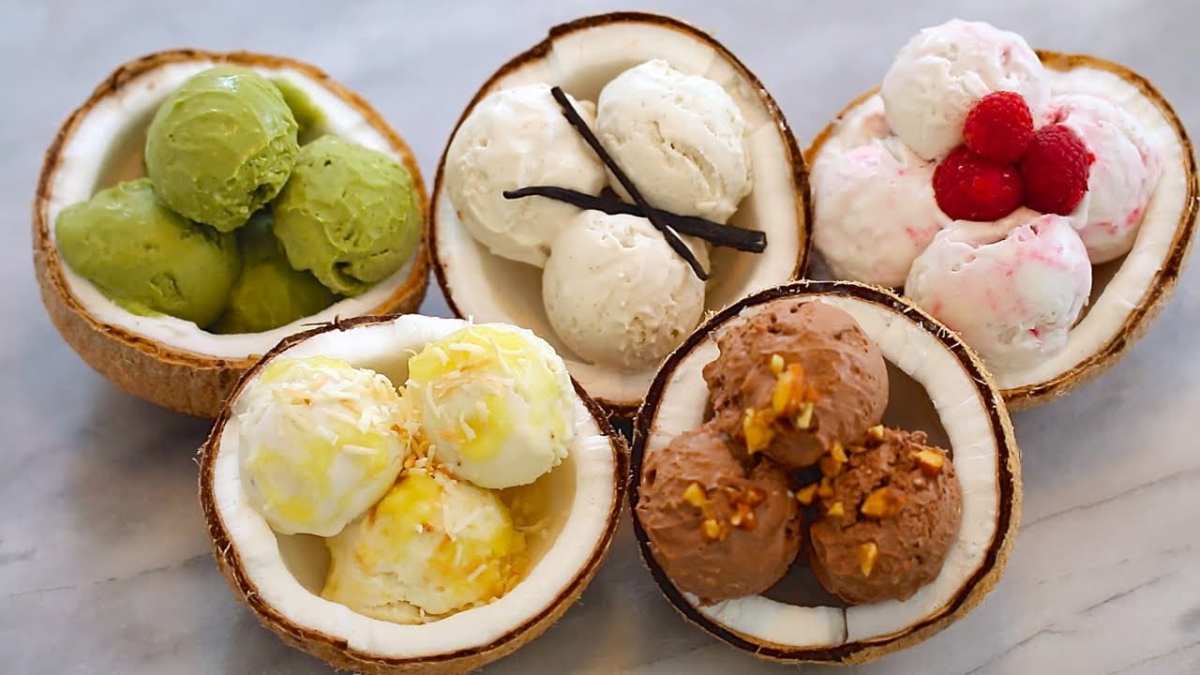Dive into the creamy, cool world of homemade vegetarian ice cream! Forget artificial ingredients and embrace the vibrant, natural flavors achievable with plant-based milks, fruits, and spices. This guide unveils the secrets to crafting delectable ice creams, from selecting the perfect base to mastering churning techniques, ensuring a delightful treat that’s both delicious and ethically conscious. Imagine the rich, velvety texture of coconut ice cream infused with toasted coconut flakes, or the bright, tangy burst of a mango sorbet, all made from scratch in your own kitchen.
We’ll explore a range of plant-based milk options, each imparting unique textural and flavor nuances to your creations. Learn how to harness the power of natural thickeners for a smooth, scoopable consistency, and discover innovative flavor combinations that will tantalize your taste buds. Whether you’re a seasoned ice cream aficionado or a kitchen novice, this comprehensive guide provides the knowledge and confidence to create unforgettable vegetarian ice cream masterpieces.
Ingredient Selection and Preparation
Crafting delectable vegetarian ice cream at home begins with thoughtfully selecting and preparing your ingredients. The right choices will significantly impact the final product’s texture, flavor profile, and overall creaminess. Understanding the nuances of each ingredient is key to achieving that perfect, homemade scoop.
Plant-Based Milk Selection
The foundation of any good ice cream is its base, and for vegetarian versions, this means choosing the right plant-based milk. Each type offers unique characteristics that influence the final texture and flavor. Almond milk, for instance, provides a subtly sweet and nutty flavor, resulting in a lighter ice cream with a relatively smooth texture. However, it can sometimes be a bit icy if not properly stabilized. Soy milk, on the other hand, lends a richer, creamier texture and a slightly beany flavor that some find pleasant, while others may find it overpowering. Coconut milk, especially the full-fat variety, delivers an intensely rich and creamy texture, along with a distinct coconut flavor. This works exceptionally well in tropical-themed ice creams but may be too strong for those seeking a more neutral base. The choice ultimately depends on your preferred flavor profile and desired texture.
Vegetarian Ice Cream Ingredients
The following table details common ingredients used in vegetarian ice cream making, outlining their function and potential substitutes.
| Ingredient | Function | Potential Substitutes |
|---|---|---|
| Plant-based Milk (Almond, Soy, Coconut, Oat) | Base, provides creaminess | Cashew cream, rice milk |
| Sweetener (Agave Nectar, Maple Syrup, Sugar) | Sweetness, contributes to texture | Honey (if not strictly vegan), Stevia |
| Thickener (Cornstarch, Guar Gum, Agar-Agar) | Prevents ice crystal formation, adds body | Tapioca starch, xanthan gum |
| Flavorings (Vanilla Extract, Cocoa Powder, Fruit Purees) | Adds flavor and color | Other extracts (mint, almond, etc.), spices (cinnamon, cardamom), chocolate chips |
| Stabilizers (Lecithin) | Improves texture and prevents separation | None – can be omitted, but may affect texture slightly |
Ingredient Preparation Techniques
Proper preparation of ingredients is crucial for achieving optimal flavor and texture in your homemade vegetarian ice cream. For instance, when using fruits, puréeing them beforehand ensures a smooth, consistent texture throughout the ice cream, preventing chunks of fruit from disrupting the creamy consistency. A simple method involves blending the fruit until completely smooth, straining it if desired to remove seeds or fibers. Roasting nuts before incorporating them into your ice cream recipe adds a depth of flavor and enhances their natural oils, contributing to a richer, more decadent texture. Roasting involves spreading the nuts in a single layer on a baking sheet and baking them in a preheated oven at 350°F (175°C) for about 8-10 minutes, or until fragrant and lightly browned. Remember to let them cool completely before using them in your ice cream base.
Serving and Storage

Presenting your homemade vegetarian ice cream is half the fun! The creamy texture and vibrant colors deserve a stage, and a little attention to detail can elevate the experience from simple dessert to a memorable treat. Proper storage is equally crucial to preserving its deliciousness.
Visually Appealing Presentation
Transforming your ice cream into a culinary masterpiece begins with the serving vessel. Imagine scoops nestled in elegant bowls, perhaps etched glass for a sophisticated touch, or rustic ceramic bowls for a homey feel. The color contrast between the ice cream and the bowl can significantly enhance the visual appeal. For instance, a pale pistachio ice cream served in a deep cobalt blue bowl creates a striking contrast, drawing the eye immediately to the creamy swirls. A rich chocolate ice cream, on the other hand, looks magnificent in a simple white bowl, allowing its deep brown hue to be the star.
Toppings add another layer of visual interest. Consider a scattering of fresh berries – the deep crimson of raspberries, the jewel-toned blueberries, or the sunshine yellow of sliced peaches – providing a burst of color and texture. A drizzle of melted dark chocolate, forming delicate, glossy ribbons across the surface, adds a sophisticated touch. Finely chopped nuts, like pistachios or toasted almonds, provide textural contrast and visual intrigue with their speckled appearance. A sprinkle of cocoa powder, creating a light dusting of deep brown, can enhance the richness of a chocolate ice cream.
Proper Storage Techniques
Proper storage is paramount to maintaining the quality and preventing freezer burn in your homemade vegetarian ice cream. Air exposure is the enemy; it leads to ice crystals and a loss of flavor and texture. The ideal storage container is an airtight container, preferably one made of a material that won’t impart flavors or odors to the ice cream. Plastic containers are readily available, but glass containers are a more sustainable and aesthetically pleasing option.
Optimal storage temperature is, of course, 0°F (-18°C) or below. The freezer should be consistently maintained at this temperature to prevent fluctuations that could cause ice crystals to form. Aim to consume your homemade ice cream within 2-3 months for optimal quality, although it may remain safe to consume for longer periods.
Preventing Ice Crystals and Reviving Icy Ice Cream
Ice crystals are the bane of perfectly smooth ice cream. To minimize their formation, ensure the ice cream is properly cooled before freezing. This minimizes the amount of ice crystals that will form during the initial freezing process. Pressing a piece of plastic wrap directly onto the surface of the ice cream before sealing it helps prevent air exposure and the formation of large ice crystals.
If your ice cream does develop ice crystals, don’t despair! Allow it to soften slightly at room temperature, then use an immersion blender or a food processor to gently blend the ice cream until it’s smooth again. A few minutes of blending usually does the trick, restoring its creamy texture. Remember to avoid over-processing, as this can incorporate too much air and make the ice cream less dense.
Recipe and Step-by-Step Instructions
This recipe provides a detailed guide to creating a creamy, delicious, and completely vegetarian ice cream at home. The process is straightforward, requiring readily available ingredients and basic kitchen equipment. The result is a homemade treat that rivals store-bought versions, with the added satisfaction of knowing exactly what went into it.
Ingredients and Measurements
The following list provides the precise measurements for a batch of rich and flavorful vanilla bean ice cream. Feel free to adjust quantities based on your needs and preferences. Remember to use high-quality ingredients for the best results.
- 2 cups heavy cream
- 1 cup whole milk
- ¾ cup granulated sugar
- 1 teaspoon vanilla extract
- 1 vanilla bean, split and seeds scraped (or 2 teaspoons vanilla bean paste)
- Pinch of salt
Step-by-Step Ice Cream Making Process
This section details each step involved in creating your homemade vegetarian ice cream, from combining ingredients to the final freezing process. Careful attention to each step will yield a smooth and creamy texture.
- Combine Ingredients: In a medium saucepan, combine the heavy cream, whole milk, sugar, vanilla bean seeds (and pod if using), vanilla extract, and salt. The mixture at this stage will appear milky white, with flecks of vanilla bean visible. The sugar will be fully incorporated but may not be completely dissolved yet.
- Heat and Stir: Gently heat the mixture over medium-low heat, stirring constantly to prevent scorching. The goal is to dissolve the sugar completely and gently warm the cream. The mixture will begin to steam slightly as the sugar dissolves. Avoid boiling. The color will remain largely unchanged.
- Cool and Chill: Remove the saucepan from the heat and let the mixture cool completely. This is crucial to prevent ice crystals from forming during churning. Once cooled, cover the mixture and refrigerate for at least 4 hours, or preferably overnight. During this chilling period, the mixture will thicken slightly and become more homogenous. The color will remain consistent.
- Churn the Mixture: Pour the chilled mixture into your ice cream maker and churn according to the manufacturer’s instructions. This typically takes 20-30 minutes. During churning, the mixture will gradually transform from a liquid into a soft-serve consistency. The color will remain unchanged, but the texture will transition from a liquid to a creamy, slightly aerated consistency.
- Freeze for Optimal Hardness: Once churned, the ice cream will have a soft-serve texture. Transfer it to an airtight container and freeze for at least 2-4 hours to allow it to harden completely. After freezing, the ice cream will have a firm, scoopable consistency. Its color will remain consistent, and the texture will be dense and creamy.
Troubleshooting Common Issues
Even with careful preparation, some challenges may arise. Here are solutions for common problems encountered during homemade ice cream production.
- Problem: Ice crystals in the final product. Solution: Ensure the mixture is thoroughly chilled before churning. Avoid over-churning, and freeze the ice cream quickly after churning.
- Problem: Ice cream is too soft after freezing. Solution: Freeze the ice cream for a longer period. Make sure your freezer is set to the correct temperature.
- Problem: Ice cream is too hard and difficult to scoop. Solution: Let the ice cream sit at room temperature for a few minutes before scooping. Consider using a warm spoon or ice cream scoop.
Creating homemade vegetarian ice cream is a rewarding culinary journey, allowing you to experiment with flavors and textures, resulting in a delicious and personalized frozen treat. From the initial selection of creamy plant-based milks to the final flourish of artful toppings, each step contributes to a unique and satisfying experience. The ability to control ingredients ensures a healthier, more ethically conscious dessert, while the creative process empowers you to craft ice creams that perfectly reflect your tastes. So, gather your ingredients, unleash your inner chef, and prepare to be amazed by the delightful results of your homemade vegetarian ice cream adventure. The smooth textures, vibrant colors, and delightful flavors await!
Clarifying Questions
Can I use frozen fruit in my vegetarian ice cream?
Yes, frozen fruit can work well, but you may need to adjust the amount of liquid in your recipe to compensate for the added moisture. Slightly thawed fruit blends better.
How long does homemade vegetarian ice cream last?
Properly stored in an airtight container in the freezer, homemade vegetarian ice cream can last for 2-3 months. However, quality may diminish after a couple of months.
What if my ice cream is too icy?
This often happens if the ice cream hasn’t been churned enough or if it’s been subjected to temperature fluctuations. Try letting it soften slightly, then re-churn it briefly.
Can I make this ice cream without an ice cream maker?
Yes, you can! However, the texture may be slightly icier. Frequent stirring during the freezing process helps to mitigate this.


